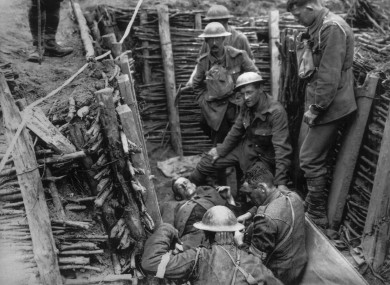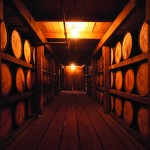Ireland’s Forgotten WW1 Hero’s

Last year marked the 100th anniversary of the outbreak of the Great War, a brutal and bloody conflict in which millions died on the battlefields of Europe and beyond. Among those many who enlisted were over 200,000 Irish men who answered the call to fight on the Allied side. Many of these went on to make the ultimate sacrifice, giving their lives in the fight for freedom. Garda Journal now recount the exploits of a selection of those Irish regiments who fought valiantly and with great distinction during those tumultuous years.
ROYAL DUBLIN FUSILIERS
The Royal Dublin Fusiliers were an Irish Infantry Regiment in the British Army, one of eight Irish regiments raised and garrisoned in Ireland, eventually disbanded in 1922 under the terms of the Anglo-Irish Treaty. The regiment was created on 1 July 1881 as a result of Childers reforms by the amalgamation of the 102nd Regiment of Foot (Royal Madras Fusiliers) and the 103rd Regiment of Foot (Royal Bombay Fusiliers) whose predecessors had been in the service of the East India Company. After the Indian Rebellion of 1857 the East India Company’s private armies were transferred to the British Army. Under the reforms five infantry battalions were given Irish territorial titles and the 102nd and 103rd Regiments of Foot became the 1st Battalion, The Royal Dublin Fusiliers.
Having fought with great distinction in the Boer War (Winston Churchill wrote glowingly of the gallantry displayed by the men of the Royal Dublin Fusiliers in his war memoirs) the regiment went on to further distinguish themselves in the Great War. At the start of the war the regiment had an establishment of five battalions and raised a further 6 battalions during the war, serving on the Western Front, Gallipoli, Middle East and Salonika.
The Dublin Fusiliers received three Victoria Crosses, forty-eight Battle Honours and five Theatre Honours. The Regiment lost just over 4,700 killed and many thousands wounded during the war. During WWI the regiment raised a total of 11 battalions. The 1st, 6th and 7th Dublins all took part in the Gallipoli campaign. The 2nd Dublins arrived in France in the month war was declared in 1914as part of 4th Division.
The 8th and 9th Dublins, arrived in France in December 1915. The 10th arrived in France in August 1916. The 3rd (Reserve), 4th (Extra Reserve) and 5th (Extra Reserve) Battalions were mobilised on 4 Aug 1914 at Naas and Dublin. These battalions served variously in Ireland, England, Wales and Scotland. The 11th (Reserve) Battalion was formed at Dublin in July 1916 and by Jan 1918 it was located in Aldershot.
All the war-raised battalions were disbanded either during the war, or shortly afterwards. The 1st Dublins crossed the German border in early December. The Battalion eventually reached Cologne where the British Army of Occupation in Germany was based. The Battalion returned to the UK a short while afterwards, based in Bordon. The 2nd Dublins left war-ravaged Europe to join the Allied Army of Occupation in Constantinople, Turkey and in late 1920 moved to Multan, India, before returning to the UK in 1922.
Due to substantial defence cuts, and the establishment of the Irish Free State in 1922, it was agreed under the terms of the Anglo-Irish Treaty that the six former Southern Ireland regiments (out of a total of thirteen Irish regiments) would be disbanded, including the Royal Dublin Fusiliers. On 12 June, the six regiments Colours with the exception of the South Irish Horse who sent a Regimental Engraving, because the regiment chosen to have its Standard remain in St. Patrick’s Cathedral, Dublin — were laid up in a ceremony at St George’s Hall, Windsor Castle in the presence of HM King George V.
ROYAL MUNSTER FUSILIERS
Based in Tralee, the Royal Munster Fusiliers were an infantry regiment originally formed in 1881, and served in India before the outbreak of the Great War. Disbanded in 1922 following the establishment of the independent Irish Free State, the regiment won three Victoria crosses during the conflict.
Landing with the British Expeditionary Forces in 1914, the regiment saw near-constant action throughout the duration of the war, serving on a number of fronts, and suffered a high number of casualties during fierce fighting in some of the bloodiest battles of the war.
Their first notable success was at the Battle of Mons in August 1914. The Germans were pushing their advance when on 27 August the 2nd Battalion of the regiment was chosen for the arduous task of forming the rearguard to cover the retreat of the 1st Division during the Battle of Mons.
The Munsters were only to retreat if ordered. They made an epic stand, losing nine officers and 87 other ranks holding out in a renowned action at the village of Etreux, many others surrounded and taken prisoner. They stemmed the Germans who were five or six times their strength for over a day, allowing their division to escape. The loss of an entire battalion so early in the war was a disaster for the regiment.
When the scattered battalion reassembled on 29 August it was down to a mere 5 officers and 196
others. These were withdrawn, seeing action most notably at Langemarck, Belgium on 22 October. By 5 November, recruits from home brought its strength back up to over 800 men.
The regiment went on to suffer catastrophic losses at the ill-fated Gallipoli campaign in 1915. Turkey had joined the Central Powers’s side in November 1914, and the object of the Gallipoli landing on the Dardanelles peninsula was to open the Dardanelles Strait in the Battle of Gallipoli to enable Allied relief convoys reach Russia.
Aboard the SS River Clyde, a converted collier with a capacity for over 2,000 men, the Munster Regiment arrived on 25 April together with the 1st Battalion of The Royal Dublin Fusiliers and some companies of the Royal Hampshires. The ship ran gently ashore, its exit bows facing the beach, for what was to be the grossly mismanaged British “V” beach landing at Cape Helles.
Small boats first carried companies of Dubliners to the beach, when four hidden Turkish machine gun posts opened fire and decimated them. Lighters to the shore were roped together, two companies of Munsters pouring out on to the bow’s gangway also to be ‘literally slaughtered like rats in a trap’.
Those who jumped to one side, drowned under their heavy equipment. The withering fire continued as they came down the gangways and were mown down until all boats and lighters were filled with dead and the bay a red sea of blood.
The ship’s commanding officer on being informed that they were not succeeding, replied “in British military tradition, offensives once begun are never called off”. That day the Munsters lost 70% of their men and many of their longest serving veterans. At daybreak next day just three companies of Munsters, two of Hampshires and one company Dubliners had made it to the shelter of some dunes.
On the 26th they took fort Sedd-el- Bahr overlooking the bay, charging and taking the village behind. It was in this attack that the heroic actions of William Cosgrove won the battalion’s first Victoria Cross (VC).
CONNAUGHT RANGERS
All four battalions of the Connaught Rangers served in France and Flanders during the course of the War. On August 14, 1914 the 2nd battalion arrived at the port of Boulogne in France, to cheering French crowds, as part of the original British Expeditionary Force (BEF).
Fresh, mainly newly recruited soldiers were drafted from Britain including the 5th battalion Connaught Rangers. Like their compatriots in the Royal Dublin and Royal Munster Fusiliers, the Rangers also fought valiantly in the doomed Gallipoli campaign.
The 5th Connaught Rangers landed at Anzac Cove on the Peninsula in the early hours of August 6, 1915. For the next seven weeks the Rangers fought desperately in the heat and misery of the Gallipoli Peninsula and took part in a number of actions.
Two all out attacks on the Turkish strong points on Hill 60 on August 21 and 28, resulted in very heavy casualties for the battalion.On September 29, 1915 the 5th Connaught Rangers were withdrawn to the Island of Lemnos in Greece.During the Gallipoli campaign the 5th Connaught Rangers suffered over 70% casualties with 22% fatalities. 686 officers and men were killed, wounded or taken prisoner.
220 officers and men were listed as killed or missing in action. The Gallipoli campaign had ended in utter failure and the Peninsula was evacuated in late December 1915. The Connaught Rangers made an invaluable contribution to efforts on the Balkan and Palestinian fronts against the forces of Turkey, or the Ottoman Empire as it was then known.
During the final phase of the Palestinian campaign, the 1st battalion Connaught Rangers disembarked at Suez, Egypt on April 14th 1918. From May until September they performed tours of duty on the Front Line that stretched across Central Palestine between Jerusalem and Nablus.
On September 19th 1918 General Allenby resumed his northward offensive to take the rest of Palestine. Caught by surprise and unprepared, the Turkish/ German army fell into a disorganised retreat and within 2 days the Turkish HQ garrison at Nazareth was captured.
The 1st battalion Connaught Rangers took an active part in this offensive, involved in heavy fighting at the taking of ‘Fir Hill’ on the advancing Front north of Jaffa. At the town of El Funduk the Rangers captured a Turkish artillery column intact.
It was the 1st Battalion’s final action in the Great War. In late September they were garrisoned at Jenin and later moved in to garrison the Biblical town of Nazareth. The Rangers remained in Nazareth as the battalion was badly affected by a malignant type of malaria later known as the ‘Great Influenza Epidemic’, which took the lives of many men.
The retreating Turkish army was followed into Jordan and Syria where they were defeated by Arab armies now in open revolt. Turkey capitulated on October 30th 1918 and brought an end to centuries of the rule of the Ottoman Empire in the Middle East.
On November 11th 1918 the day the Armistice came into effect the 1st battalion Connaught Rangers were still garrisoned in the town of Nazareth. Throughout December 1918 and the early months of 1919 the Connaught Rangers were demobilised and sent home.



